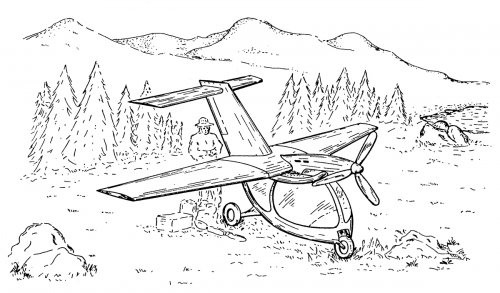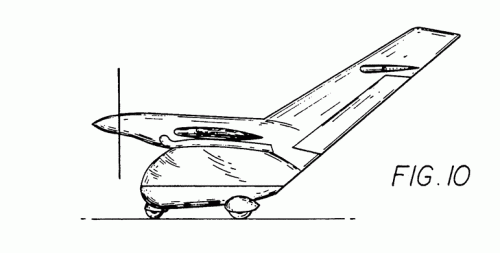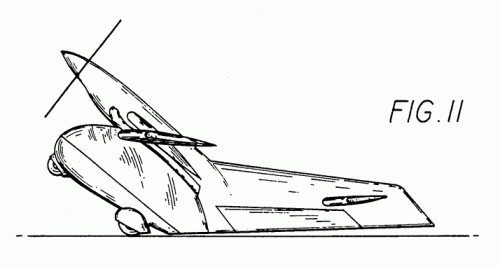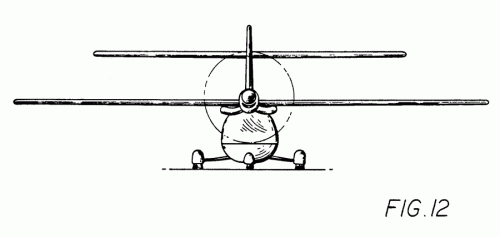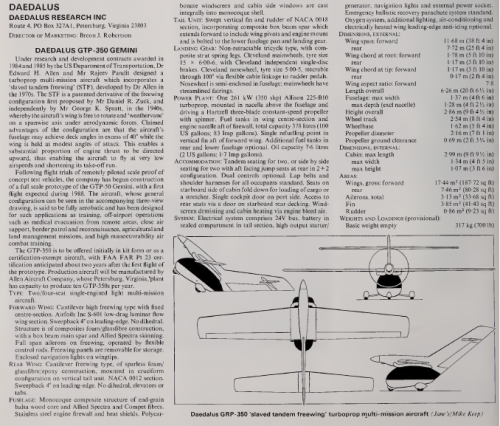Allen GTP-350 « Gemini Turborprop-350 » (1987)
The GEMINI TURBOPROP-350 is a new, innovative, single-engine, special performance aircraft. The GTP-350 is powered by Allison's soon-to-be-certified turbine, the 225-B10, delivering 350 shaft horse power (SHP). Combining the 225-B10 with the low weight, high strength characteristics of Allied's SPECTRA and COMPET Fibers creates a high-performance state-of-the-art aircraft. What really sets the GTP-350 apart, however, is the patented Slaved Tandem Freewing design; this configuration provides dramatic safety improvements as well as giving the plane near vertical take-offs and landings (VTOL). This brochure tells the story of the revolutionary GEMINI TURBOPROP-350.
HISTORY OF THE GEMINI TURBOPROP-350 PROJECT
The GEMINI TURBOPROP-350 (GTP-350) lineage began prior to World War II when George K. Spratt and Daniel R. Zuck independently invented pure `freewing` design aircraft. Spratt, the more active researcher of the two, has designed, built and flown more than a dozen freewing vehicles. Further development came in the 1950s and 60s when several other researchers--including teams from NASA, General Dynamics and Battelle Memorial Laboratories [--] reported the study, building and successful flying of freewing designs. "In early 1977, Edward H. Allen, Ph.D., a professional systems scientist and experienced pilot, began to examine freewing development and perform experiments that eventually led to the formulation of a new concept--the `Slaved Tandem Freewing` (STF) configuration. Dr. Allen believed that theoretically the new configuration could be shown to be 10 times safer than existing general aviation aircraft. As a result, when the U.S. Department of Transportation requested proposals in 1984 for innovative means to reduce accidents and increase the safety of vehicles, Dr. Allen submitted a proposal for developmental funding of the STF design. A feasibility study contract was awarded by the DOT and after evaluating the results of that study, a two-year, follow-on contract for additional development work was awarded--including the design, manufacture and testing of a manned prototype. The DOT-sponsored work included the testing of four subscale, remotely piloted research vehicles (RPRVs . . .)--the largest of which had a 17-foot wing span and weighed more than 100 pounds. The [RPRVs] served to demonstrate the concept and the GEMINI TURBOPROP-350 was born.
Construction of the full-scale manned prototype began early in 1987. Flight testing is scheduled to begin with ground tests and system check-out in October 1987, with the first flight the following month.
THRUST VECTORING: THE SECRET TO NEAR VTOL
The GEMINI TURBOPROP-350 is the world's first aircraft to offer near vertical takeoff and landing performance without the mechanical complexity of a helicopter--and without losing high speed performance. The unique STF configuration allows the pilot to control deck angle independent of the wing's angle of attack. By rotating the fuselage to a high angle of attack while leaving the wings in a level flight attitude, the pilot is able to direct or `vector` the thrust. The benefit of this `extreme flair [sic]` landing and takeoff maneuver is the ability to operate from confined areas with little takeoff run and even less landing roll.
SAFETY — THE VALUE OF THE STF CONCEPT
Ease of operation and inherent safety in vehicle design are the greatest strengths of the STF concept. Of primary importance is the fact that STF vehicles cannot be stalled or spun in the dramatic way that fixed wing aircraft can. In addition, the natural tendency of an STF system to reduce the shocks from sudden changes in wind direction--the `gust allevation` tendency--is as important as stall resistance. In aerodynamic vehicles, the freewing is comparable to an automobile's suspension system . . . : it provides a safe and comfortable flight.
SPECIFICATIONS
The fully aerobatic GTP-350 is designed for multi-mission applications. Proposed applications include training such as high maneuverability aerial combat; high performance off-airport operations such as medical and other evacuation from remote areas; close support of combat troops with helicopter-like performance; border patrol, reconnaissance, agricultural and wide area land management missions and general purpose use. The GTP-350, presently available without an FAA certificate (as either a kit or an exempt airplane), is excepted to receive FAA Part 23 certification. Allen Aircraft Company presently has production capacity for 10 GTP-350s per year. Substantial contribution to the development effort was made by Allison Division of General Motors Corporation.
DIMENSIONS, EXTERNAL:
Wing span 38.33 ft.
Chord at root 5.83 ft.
Chord at tip 3.83 ft.
Mean Aerodynamic Chord 5.45 ft.
Wing Aspect Ratio 7.60
Wing taper ratio 0.67
Sweep 4.00 deg.
Length overall 20.54 ft.
Fuselage: max width 4.50 ft.
max depth 4.20 ft. (excluding nacelle)
Height overall 9.38 ft.
Rear wing span 25.33 ft.
Rear wing chord at root 3.83 ft.
Rear wing chord at tip 2.33 ft.
Wheel track 8.33 ft.
Wheel base 5.33 ft.
Propeller diameter 85.0 inches
Propeller ground clearance 2.28 ft.
DIMENSIONS, INTERNAL:
Cabin: max length 9.80 ft.
max width 3.41 ft.
max height 3.50 ft.
AREAS:
Wings, gross 187.72 sq. ft.
Ailerons, total 33.68 sq. ft.
Exposed vertical fin 41.43 sq. ft.
Rudder 9.23 sq. ft.
Rear wings, gross 78.48 sq. ft.
WEIGHTS and LOADINGS:
Basic weight empty (typical equipment) 754 lbs.
Maximum take-off weight (acrobatic) 1500 lbs.
Maximum take-off weight (utility) 2200 lbs.
Fuel, max capacity 700 lbs.
Maximum wing loading 11.5 lbs./sq.ft.
Maximum power loading 6.28 lbs./shp
PERFORMANCE:
Never exceed speed 230 mph
Maximum level speed at sea level 190 mph
75% normal cruise 173 mph
Minimum level speed, no vectored thrust 70 mph
Minimum controllable speed, full thrust vectoring 20 mph
Maximum sustainable climb angle 90 degrees
Maximum climb rate at sea level 3520 fpm
Take-off run, no vectored thrust 1200 ft.
Take-off run, full thrust vectoring 75 ft.
Landing roll out, no vectored thrust 600 ft.
Landing roll out, full thrust vectoring 65 ft.
Service ceiling 25,000 ft.
Range with 45 min. reserves 800 n.m.g
limits, max aerobatic TOW +6/-3g
limits, max utility TOW +4.4/-2.2
CAPTIONS:
FIG. 9 is a perspective view (after promotional literature of the Allen Aircraft Company) of the prior-art Gemini Turboprop-350 (understood to be a trademark of that firm) in an environment characteristic of that craft's short takeoff-roll and short landing-rollout distances.
FIG. 10 is a diagrammatic side elevation (ibid.) of the same prior-art craft in a preliminary takeoff-roll or landing-rollout orientation wherein the fuselage is generally horizontal.
FIG. 11 is a like view (ibid.) of the same craft in a later stage of takeoff roll, in which the fuselage is oriented steeply upward.
FIG. 12 is a front elevation (ibid.) of the same craft in its FIG. 10 orientation.
Source: US Patent
US 5086993 A (design mentioned and uses as illustration)
Also see: Edward H. Allen's
Slaved tandem freewing (STF) and device [US 4967984 A]
Also read:
Flight International, 26 September 1987

